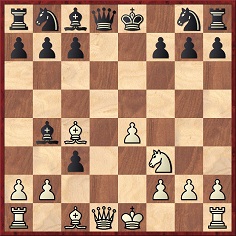Chess Notes
Edward Winter
When contacting us by e-mail, correspondents are asked to include their name and full postal address and, when providing information, to quote exact book and magazine sources. The word ‘chess’ needs to appear in the subject-line or in the message itself.
| First column | << previous | Archives [154] | next >> | Current column |
10433. Deep Thinking by Garry Kasparov
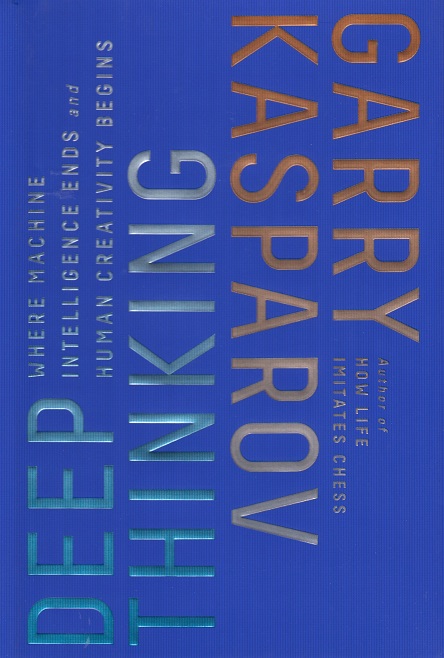
From Deep Thinking by Garry Kasparov with Mig Greengard (New York, 2017) we quote a selection of passages which focus on autobiographical matters and chess lore (rather than computers, the central theme of the book):
- ‘Thanks to the Internet’s matchless ability to spread myths and rumors, I’ve found myself bombarded with all sorts of misinformation about my own intellect. Spurious lists of “highest IQs in history” might find me between Albert Einstein and Stephen Hawking, both of whom have probably taken as many proper IQ tests as I have: zero.’ (Pages 14-15)
- ‘Despite not knowing all the rules, before I was six I solved a chess puzzle in the newspaper that had been frustrating my parents. My father, Kim, hastily got out the chess set the next day to show me how the game was played, but it always felt like I learned chess the way an infant acquires its native language. There is no luck in chess, but clearly I was lucky in my choice of birthplace and parents.’ (Page 85)
- ‘I can say without any false modesty that I was the best-prepared player in the history of chess. Even when I was very young I enjoyed studying the openings and searching for improvements to add to my arsenal. The exciting cut-and-thrust tactics of the middlegame get most of the attention, but the tenacity and ingenuity required to find a new idea in the well-trodden paths of the opening always attracted me.’ (Page 105)
- ‘I am a sore loser.
I want to clear that up right at the start. I hate losing. I hated losing bad games and I hated losing good ones. I hated losing to weak players and I hated losing to world champions.
I have had sleepless nights after losses. I have had angry outbursts at award ceremonies after a bad defeat. I have been annoyed to discover that I missed a good move in a game I lost 20 years ago when analyzing it for this book.
I hate to lose, and not just at chess. I hate to lose at trivia games. I hate to lose at card games. (My complete lack of a poker face is why I rarely play them.)
Being a sore loser is not the attribute I’m most proud of, nor am I ashamed of it. To be the best in any competitive endeavor you have to hate losing more than you are afraid of it.’ (Page 113)
- ‘Paradoxically, when other top players wrote about games in magazines and newspaper columns they often made more mistakes in their commentary than the players had made at the board. Even when the players themselves published analyses of their own games they were often less accurate than when they were playing the game.’ (Page 138)
- ‘After I beat him heavily in a match in 1986, English GM Tony Miles called me “a monster with a thousand eyes who sees all”. I didn’t like that nickname any more than I liked being called the “Beast of Baku” (el Ogro de Baku in Spanish, I’m told), but I suppose it was a compliment. My ability to see in seconds what even experienced Grandmasters needed minutes to work out was what first drew me to the attention of Mikhail Botvinnik when I was a child. I wasn’t a machine, or an all-seeing monster, but I was about as close as a human could get when it came to chess.’ (Page 175) [For Miles’ description of Kasparov on page 3 of the Basler Zeitung, 23 May 1986 (‘eine Arte Monster mit hundert Augen’) see Kasparov v Miles, Basle, 1986.]
- ‘I won’t hide from the fact that I did make regrettably sexist remarks about women in chess around this time. In that 1989 Playboy interview I said men were better at chess because “women are weaker fighters” and that “probably the answer is in the genes”. The possibility of gender brain differences aside, I find it almost hard to believe I said this considering that my mother is the toughest fighter I know.’ (Page 268)
- ‘Publications deciding on the English spelling of my first name used to fluctuate between Gary, Garry and even Garri, but I prefer Garry.’ (Page 269)
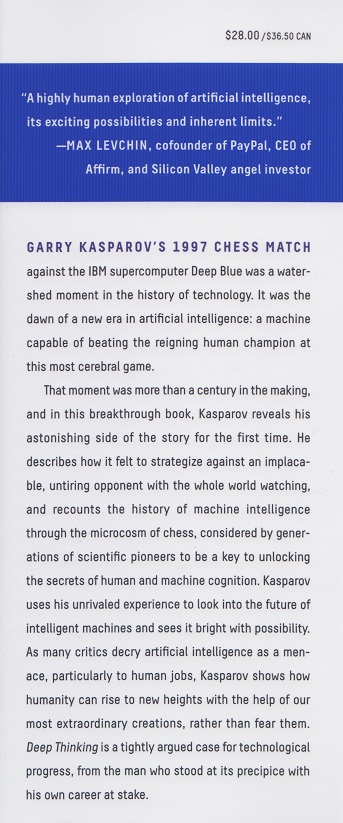
The inside dust-jacket of Deep Thinking
From page 92:
‘It was hard to not recall the retort attributed to Bobby Fischer when an eager fan pressed him after a difficult win. “Nice game, Bobby!” Fischer answered, “How would you know?”’
The corresponding endnote on page 267:
‘I was told this story in Buenos Aires, Argentina, and have no way to know if it’s true. But it definitely sounds like something Fischer might say. It is also bitingly insightful, as few fans would have any idea of the quality of a world champion’s game without expert commentary. Today it’s quite different, when everyone has a super-strong engine at his disposal and feels empowered to scoff at the champion’s mistakes as if they’d found them themselves.’
On the Fischer matter we add that in the late 1980s Stewart Reuben managed to become a BCM columnist and that on page 338 of the August 1989 issue he wrote this ‘once’ story:
‘Jimmy Adams once said to Fischer in Monaco, “Gee, Mr Fischer, that was a beautiful game you just played!” Bobby’s reply, “How would you know?”’
On page 447 of the October 1989 BCM Reuben apologized to Adams:
‘He tells me this never took place and that the only words that ever passed between them were “Excuse me”.’
Kasparov’s observation about people pointing out a champion’s mistakes ‘as if they’d found them themselves’ makes us wonder how often he has been the victim of a common piece of annotational malpractice: in a book or article a champion (e.g. Capablanca or Alekhine) presents analysis which is an improvement on his actual play, and a subsequent annotator (e.g. Panov or Kotov) reproduces the same variations anonymously, as if they were his own discovery. There cannot be many areas of human activity where a critic has the opportunity to act that way.
The final acknowledgement on page 262 of Deep Thinking is to ‘My collaborator of nearly 19 years, Mig Greengard, whose former lives in programming and chess made him even more indispensable than usual on this project’. The book’s fine prose and general editing underscore how poorly Kasparov and Everyman Chess served each other. (One small correction, concerning page 81: Lasker’s Common Sense in Chess was dated 1896, and not 1910.)
Kasparov’s Deep Thinking is an absorbing, often brilliant, book which no chess lover should miss.
10434. Lasker and Steinitz (C.N. 10426)
C.N. 10426 quoted from page 67 of CHESS, February 1941 a remark ascribed by W.H. Cozens to Hans Kmoch:
‘Just as some players sacrifice pawns for an attack, so Lasker frequently sacrifices time and space to keep the game alive.’
Neil Blackburn (Redditch, England) draws attention to an observation by Lasker about Steinitz (Lasker’s Chess Magazine, August-September 1906, page 182) concerning the opening game of their first world championship match (New York, 15 and 16 March 1894), in which Lasker was White. 1 e4 e5 2 Nf3 Nc6 3 Bb5 d6 4 d4 Bd7 5 Nc3:
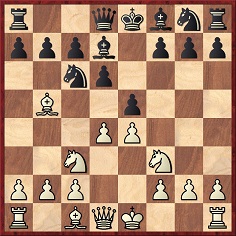
Steinitz now played 5...Nge7.
Lasker wrote:
‘I did not try for more than the slight advantage which naturally accrues to the first player from a somewhat quicker development. Steinitz played an absolutely sound defence to my Ruy López, such as with slight modification has come into vogue at the present moment. Still, his fifth move left something to be desired, as it advanced Black’s development only to a small degree. But quick development was not a thing which Steinitz aimed at.
He was satisfied with a development sufficiently rapid to meet attacks, but sufficiently backward to leave many pieces unexchanged and to lead to many complications – an ingenious idea of which nobody but Steinitz has ever known, the masterly execution.
It was in the nature of things that Black’s king’s knight had to make many moves before it arrived at a stable position. The fifth move implied that necessity.’
Pages 183-184 had Steinitz’s annotations to the game. The first two notes:
After 3...d6: ‘The revival of this defence met with much opposition, but I have seen nothing as yet to vitiate the equalizing effect which, in my opinion, it possesses.’
After 5...Nge7: ‘An important key-move to this defence, which I first adopted in my match against Gunsberg.’
Steinitz was referring to the second game of his 1890-91 match against Gunsberg, which began 1 e4 e5 2 Nf3 Nc6 3 Bb5 d6 4 c3 Bd7 5 O-O Nge7.
Steinitz’s notes to the above-mentioned Lasker game were published in the New York Recorder of 18 March 1894. An account by Lasker had appeared in the New York Daily Tribune the previous day.
10435. Quotes about Lasker
The Introduction to Why Lasker Matters (London, 2005) begins, on page 3, with Soltis’s signature sourcelessness:
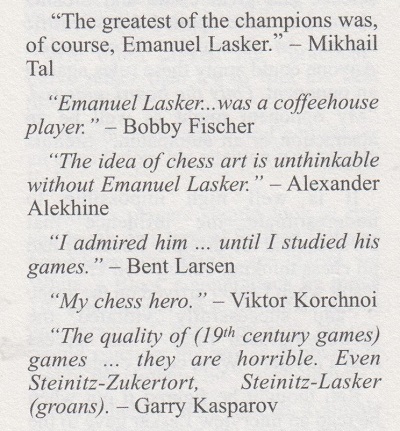
10436. Translating Nimzowitsch
Sean Robinson (Tacoma, WA, USA) notes three translations (with the adjectives ‘curious’, ‘peculiar’ and ‘unique’) of a remark by Nimzowitsch about Tarrasch’s Die Moderne Schachpartie:
- ‘The collection of games published by Dr Tarrasch under the above title actually constitutes a critical opening manual in a curious form.’ My System (Göteborg, 2007), page 270, translated by Ian Adams;
- ‘The game collection published by Dr Tarrasch, under the above mentioned title, is actually a critical textbook on the opening in a peculiar form.’ Aron Nimzowitsch On the Road to Chess Mastery, 1886-1924 by Per Skjoldager and Jørn Erik Nielsen (Jefferson, 2012), page 204;
- ‘The collection of games published by Dr Tarrasch under the title Die Moderne Schachpartie really represents a critical textbook on the openings in a unique form.’ My System & Chess Praxis (Alkmaar, 2016), page 285, translated by Robert Sherwood.
Our correspondent writes:
‘The three adjectives have slightly different connotations. What was written originally?’
Nimzowitsch’s text on page 73 of the March-April 1913 Wiener Schachzeitung was:
‘Die von Dr. Tarrasch unter obigem Titel herausgegebene Partiensammlung stellt eigentlich ein kritisches Lehrbuch der Eröffnungen in eigenartiger Form dar.’
Mr Robinson also comments that a few paragraphs later the books have, respectively, these translations for Nimzowitsch’s description of Tarrasch: ‘he is relentlessly single-minded’, ‘he is inexorably rigid’ and ‘we see a relentless linearity’.
In the Wiener Schachzeitung Nimzowitsch wrote that Tarrasch was ‘von einer unerbittlichen Gradlinigkeit’.
10437. Another prodigy
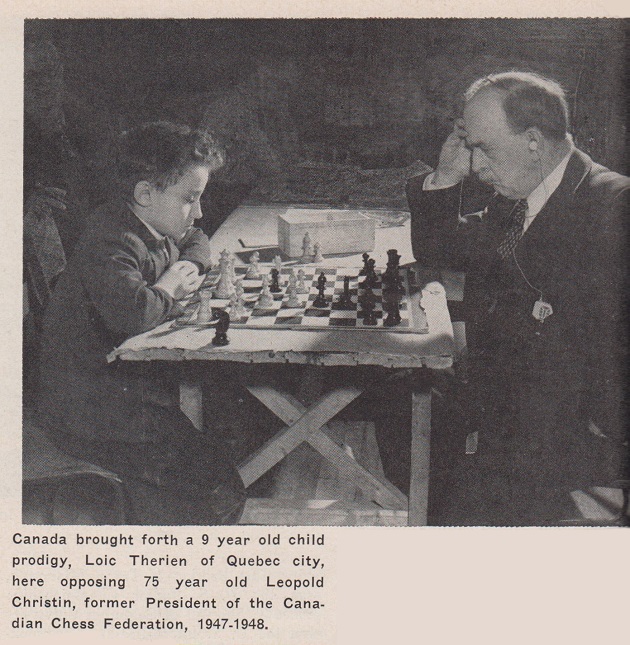
Source: Chess Review, January 1953, page 4.
10438. English and French quotations
From page 39 of Essential Chess Quotations by John C. Knudsen (Falls Church, 1998):
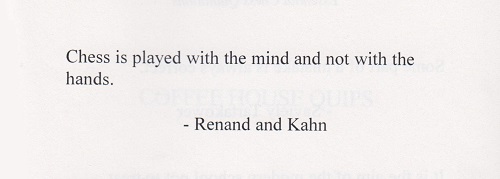
‘Renand’ should read Renaud, of course. The remark appears on page 56 of The Art of the Checkmate (New York, 1953):
‘Do not forget that chess is played with the mind and not with the hands!’
As so often, the original text has been forgotten. From page 59 of Renaud and Kahn’s L’art de faire mat (Monaco, 1947):
‘C’est avec la tête que l’on doit jouer aux échecs et non pas avec les doigts.’
10439. Fiske and hoaxes
C.N. 3439 (see A Chess Whodunit) quoted from a letter dated 27 March 1926 from John G. White to John Keeble:
‘I am surprised at your telling me that Mr Murray still believes in the Rou Manuscript. Fiske dearly loved such mystifications in his younger days, and when his memory of this particular one was revived by my correspondence with him the zest returned – hence his correspondence with Notes & Queries and his later elaborate attempts to bolster up the story. How he came to father it on the particular person that he did I do not know, and cannot guess, but I presume his reading advised him of the existence of the person and he knew it would be impossible to dispute his statement. I think in former letters I have told you of some of his more elaborate hoaxes.’
We asked for information about hoaxes allegedly perpetrated by Fiske, and the matter has now been taken up by Harrie Grondijs on pages 52-54 of volume four of Chess Craze Bad (Maastricht, 2017), a 237-page hardback subtitled ‘Daniel Willard Fiske, chess bibliophile and chess visionary’.
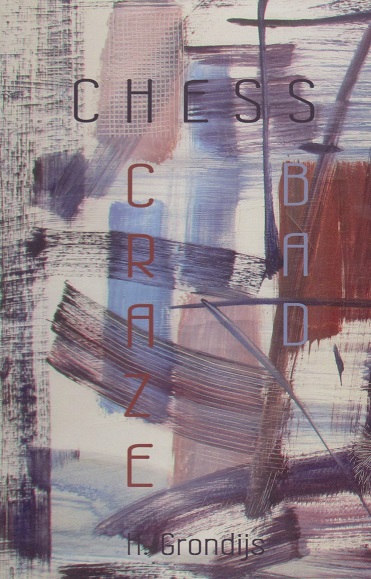
The relevant section, entitled ‘A real Fiske hoax’, follows up on the account of Fiske and Frère’s involvement in the Morphy-Staunton controversy in Chapter four of Thomas Frère and the Brotherhood of Chess by Martin Frère Hillyer (Jefferson, 2007). In describing a rancorous public argument between ‘Pro Recto’ and ‘Sancho Panza’, Martin Frère Hillyer identified the pseudonymous letter-writers as Fiske and Frère respectively, but Mr Grondijs demonstrates, with documentary proof, that this is not so. From page 53:
‘... the letters on both sides were written by Fiske: he played the parts of both “Pro Recto” and “Sancho Panza”.’
Produced in accordance with Harrie Grondijs’ usual fine standards, volume four of Chess Craze Bad has a print-run of only 37 copies. A comprehensive list of his books can be found in the catalogue of the Royal Library in The Hague. [Updated link.]
10440. Age
The comment about John Keeble in the passage below is strange, as are various other age references:
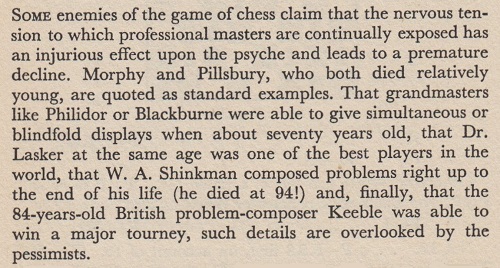
Source: page 86 of Master Chess by Lodewijk Prins (London, 1950).
The Dutch original:
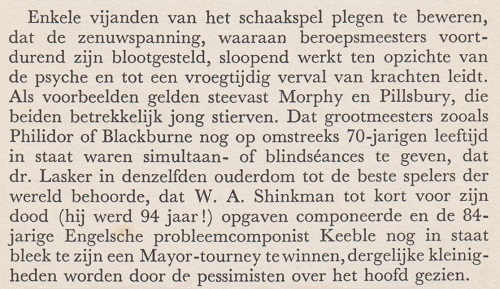
Source: page 81 of Met de schaakmeesters op oorlogspad (Amsterdam, 1940). The book was undated but was reviewed on page 144 of the May-June 1940 Tijdschrift van den Koninklijken Nederlandschen Schaakbond.
10441. Maróczy games
Eduardo Bauzá Mercére (New York, NY, USA) sends three games played by Géza Maróczy, against C.E. Norwood, S.S. Cohen and H. Steiner, in the 1925-26 Manhattan Chess Club Championship in New York:
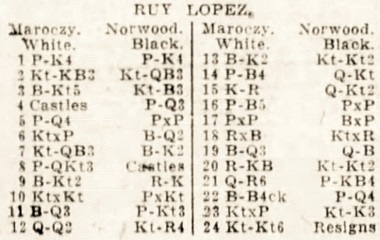
Brooklyn Daily Eagle, 21 January 1926, page 4A
1 e4 e5 2 Nf3 Nc6 3 Bb5 Nf6 4 O-O d6 5 d4 exd4 6 Nxd4 Bd7 7 Nc3 Be7 8 b3 O-O 9 Bb2 Re8 10 Nxc6 bxc6 11 Bd3 g6 12 Qd2 Nh5 13 Be2 Ng7 14 f4 Qb8 15 Kh1 Qb7
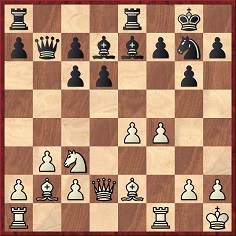
16 f5 gxf5 17 exf5 Bxf5 18 Rxf5 Nxf5 19 Bd3 Qc8 20 Rf1 Ng7 21 Qh6 f5 22 Bc4+ d5 23 Nxd5 Ne6 24 Nb6 Resigns.
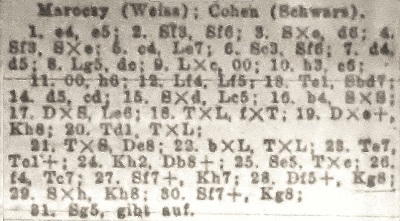
New-Yorker Staats-Zeitung, 14 March 1926, page 7D
1 e4 e5 2 Nf3 Nf6 3 Nxe5 d6 4 Nf3 Nxe4 5 c4 Be7 6 Nc3 Nf6 7 d4 d5 8 Bg5 dxc4 9 Bxc4 O-O 10 h3 c6 11 O-O h6 12 Bf4 Bf5 13 Re1 Nbd7 14 d5 cxd5 15 Nxd5 Bc5
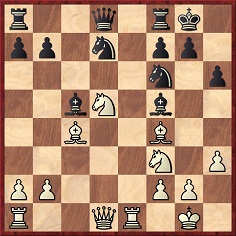
16 b4 Nxd5 17 Qxd5 Be6 18 Rxe6 fxe6 19 Qxe6+ Kh8 20 Rd1 Rxf4 21 Rxd7 Qe8 22 bxc5 Rxc4 23 Re7 Rc1+ 24 Kh2 Qb8+ 25 Ne5 Rxc5 26 f4 Rc7 27 Nf7+ Kh7 28 Qf5+ Kg8 29 Nxh6+ Kh8 30 Nf7+ Kg8 31 Ng5 Resigns.

New York Sun, 15 February 1926, page 34
The game was also published on page 4A of the Brooklyn Daily Eagle, 4 March 1926.
1 d4 Nf6 2 Nf3 e6 3 Bg5 c5 4 e3 b6 5 c4 Be7 6 Nc3 Bb7 7 Bd3 O-O 8 O-O cxd4 9 exd4 d5 10 cxd5 Nxd5 11 Ne4 h6 12 Bd2 Nc6 13 a3 Nf6 14 Bc3 Nd5 15 Re1 Rc8 16 Bd2 Nf6 17 Bc3 Nb8 18 Nxf6+ Bxf6 19 Ne5 Bd5 20 Re3 Bg5 21 Rh3 f5 22 Bb4 Rf6 23 g3 f4 24 Bc2 Qc7 25 Bc3 Nd7 26 Rh5 fxg3 27 hxg3 Nxe5 28 dxe5
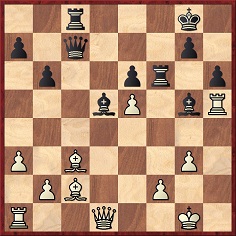
28...Rxf2 29 Kxf2 Rf8+ 30 Ke1 Qf7 31 Qe2 Bf3 32 Rxh6 Bxh6 33 Qf2 Qh5 34 Bd4 Be2 35 Bg6 Qh1+ 36 Qg1 Rf1+ 37 Kxe2 Qf3 mate.
The outcome of the Championship was reported on page 44 of the March 1926 American Chess Bulletin:
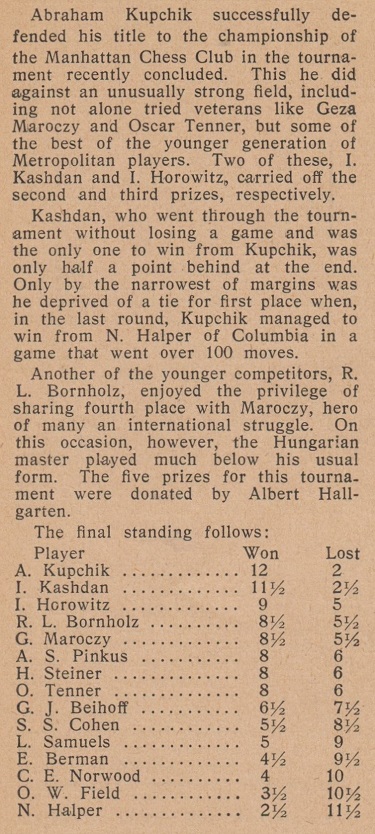
The full crosstable, credited to page 25 of the New York Sun, 6 March 1926, is on page 690 of Jeremy Gaige’s fourth volume of crosstables (Philadelphia, 1974).
Notwithstanding Cassel’s remarks above in praise of Steiner v Maróczy, it was recorded on page 12 of the Yonkers Statesman (New York), 1 April 1926 and on page 60 of the April 1926 American Chess Bulletin that Maróczy v Norwood was selected as the most brilliant game of the tournament. It was also published on page 16 of the 20 January 1926 edition of the New York Evening Post:
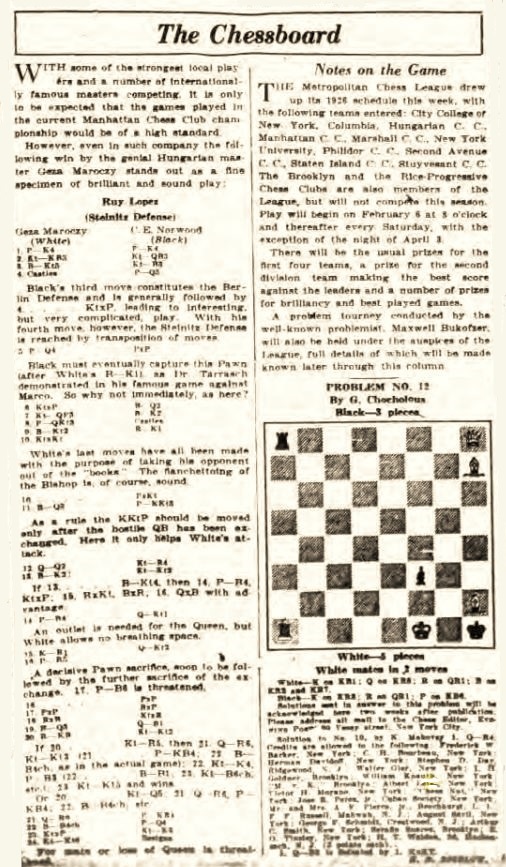
10442. Capablanca and living chess (C.N. 4092)
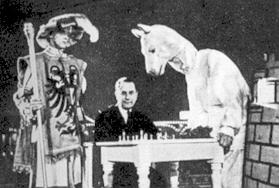
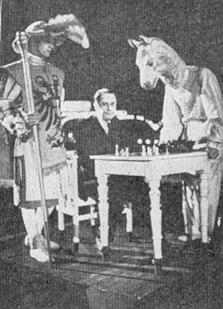
C.N. 4092 showed the above photographs, of which the former is familiar from page 201 of A History of Chess by Jerzy Giżycki (London, 1972).
Jan Kalendovský (Brno, Czech Republic) notes that it had been published on pages 2-3 of the Prager Presse, 3 August 1930, and he also provides a further shot, from an unknown publication.
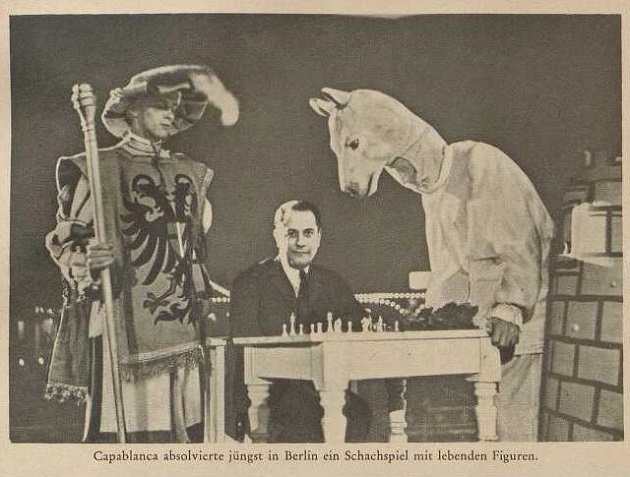
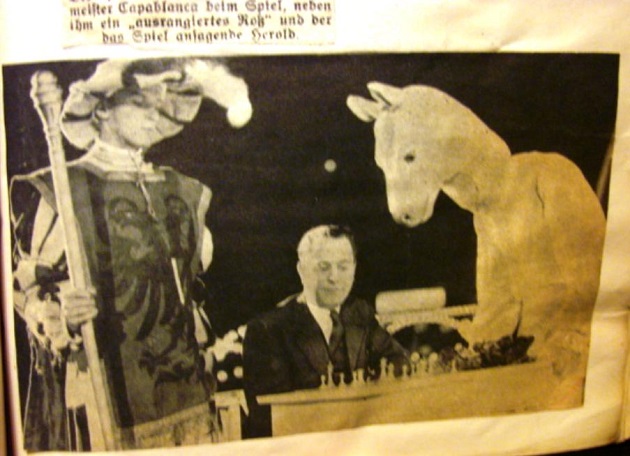
10443. P-KB4 and P-KR4 (C.N. 10422)
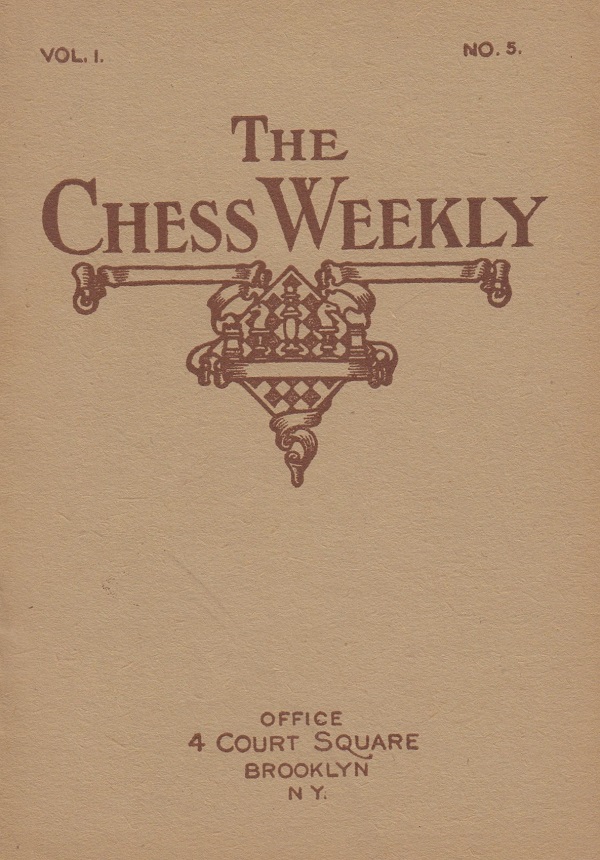
C.N. 10422 showed this item from page 34 of issue five of the Chess Weekly, 4 July 1908:
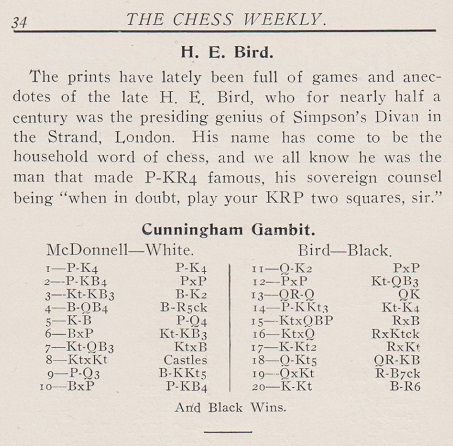
Concerning the remark that Bird ‘was the man that made P-KR4 famous, his sovereign counsel being “when in doubt, play your KRP two squares, sir”’, C.N. 10422 commented that P-KR4 should evidently read P-KB4 (which was Bird’s tenth move in the game).
The origins of the alleged ‘sovereign counsel’ quote remain unknown – it can only be said that the Editors of the Chess Weekly at that time were W.E. Napier, Magnus Smith and Charles Nugent – but Richard Forster (Zurich) believes that P-KR4 was indicated intentionally. He notes, for instance, Bird’s line 1 e4 e5 2 Nf3 Nc6 3 Bb5 Nd4 4 Nxd4 exd4 5 O-O h5, as well as variations in the Sicilian Defence and the King’s Gambit, and cites this passage from page 271 of H.E. Bird by Hans Renette (Jefferson, 2016), in a section entitled ‘A Short Stop in Amsterdam 1880’:
‘Bird allowed himself his usual liberties in these games, such as recklessly advancing his a- and h-pawns, moving his king just one square aside, and playing 3...Nd4 against the Ruy López, but nevertheless crushed all opposition.’
10444. The Bxf7+/...Bb4+ theme
On page 133 of the 26 September 1908 Chess Weekly the ‘Pot Pourri’ column by C.S. Howell (‘a department in which Mr Howell will be allowed to follow his own fancy and cook his own dishes until the readers of the Chess Weekly cry quits’) included this paragraph:

1 e4 e5 2 Nf3 Nc6 3 Bc4 Nf6 4 d4 d6 5 dxe5 Nxe5 6 Nxe5 dxe5
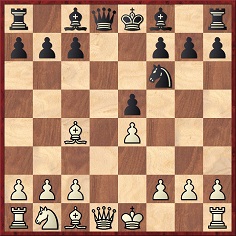
7 Bxf7+ Kxf7 8 Qxd8 Bb4+ 9 Qd2 Bxd2+ 10 Nxd2.
Wanted: other opening lines featuring the Bxf7+/...Bb4+ theme. The best-known is in the Danish Gambit: 1 e4 e5 2 d4 exd4 3 c3 dxc3 4 Bc4 cxb2 5 Bxb2 d5 6 Bxd5 Nf6 7 Bxf7+ Kxf7 8 Qxd8 Bb4+, as discussed in Chess: The Greatest.
10445. Carlo Turchi
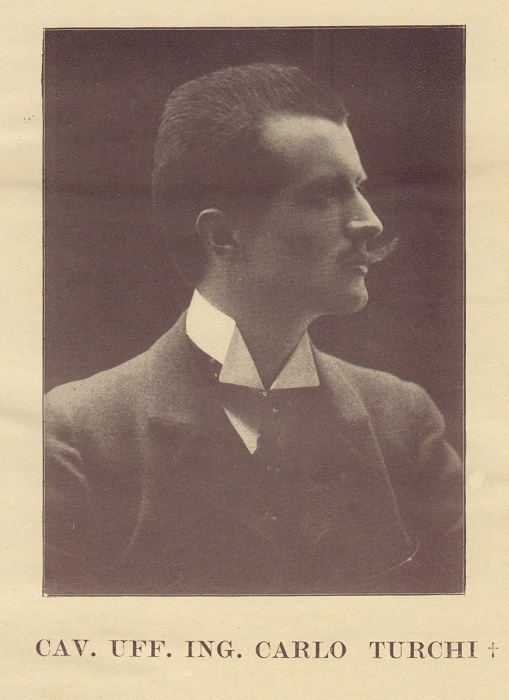
Supplement to L’Echiquier, January 1929
From page 29 of the same issue:
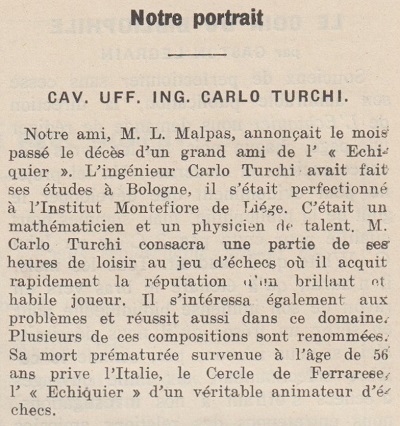
Further information about Carlo Turchi will be welcomed.
10446. Double Chess (C.N. 5619)
C.N. 5619 showed a game of Double Chess between Maróczy and Capablanca on pages 323-324 of the November 1929 issue of Magyar Sakkvilág. The game-score was also on page 197 of L’Echiquier, May 1929:
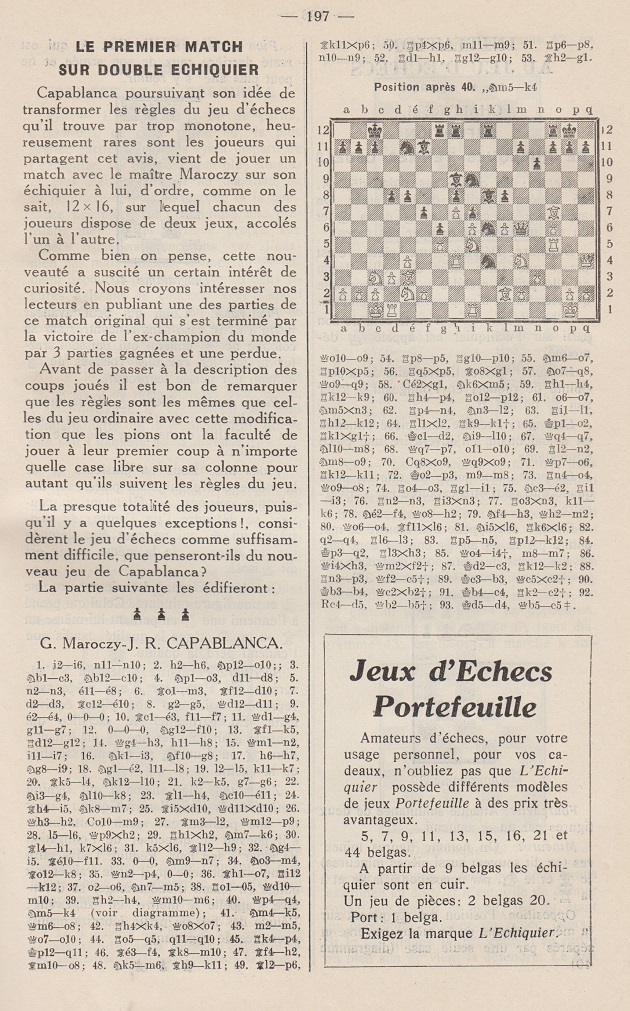
10447. The Bxf7+/...Bb4+ theme (C.N. 10444)
Luc Winants (Boirs, Belgium) notes two openings:
-
1 e4 c6 2 d4 d5 3 f3 dxe4 4 fxe4 e5 5 Nf3 exd4 6 Bc4 Bb4+ 7 c3 dxc3
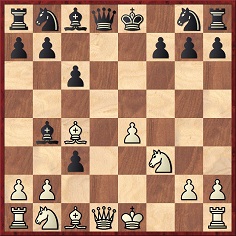
8 Bxf7+ Kxf7 9 Qxd8 cxb2+ 10 Ke2 bxa1(Q) 11 Ng5+ Kg6 12 Qe8+ and wins.
This line was given in the notes to a Teichmann v Mieses match-game on pages 332-333 of the November 1910 Deutsche Schachzeitung:
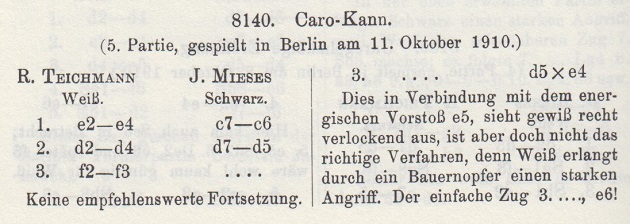
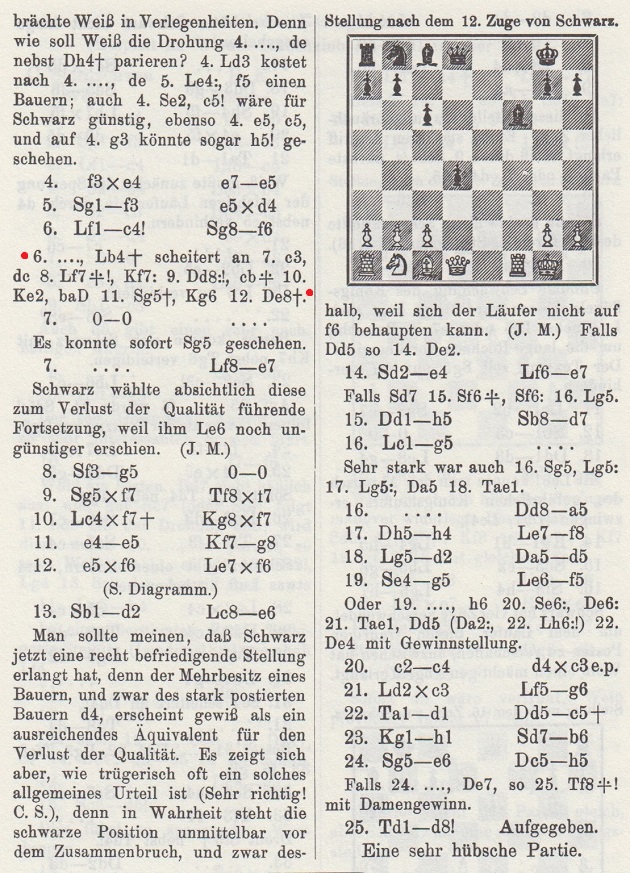
-
1 d4 d5 2 c4 c6 3 Nf3 Nf6 4 Nc3 dxc4 5 a4 Bf5 6 Nh4 Bc8 7 e4 e5 8 Bxc4 exd4 9 e5 dxc3
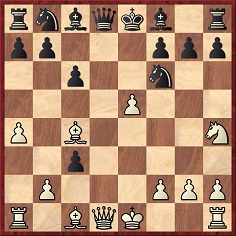
10 Bxf7+ Kxf7 11 Qxd8 cxb2 12 Qc7+ Ke6.
These were the opening moves of Larsen v Teschner, Wageningen, 1957, which Hans Kmoch annotated on page 116 of the April 1958 Chess Review. He gave two exclamation marks to 10...Kxf7 and 12...Ke6. The game was agreed drawn at move 40.
10448. H.T. Buckle
C.N.s 8346, 9526 and 9556 (see Chess: Mistaken Identity) have mentioned books which gave a picture of Buckle but named him as Bird.
One of the portraits shown in C.N. 9556 is on page 23 of H.E. Bird by Hans Renette (Jefferson, 2016), with the caption ‘Henry Thomas Buckle (Chess Player’s Magazine)’. Courtesy of the Cleveland Public Library we reproduce it below from opposite page 33 of the February 1864 issue of the Chess Player’s Magazine:
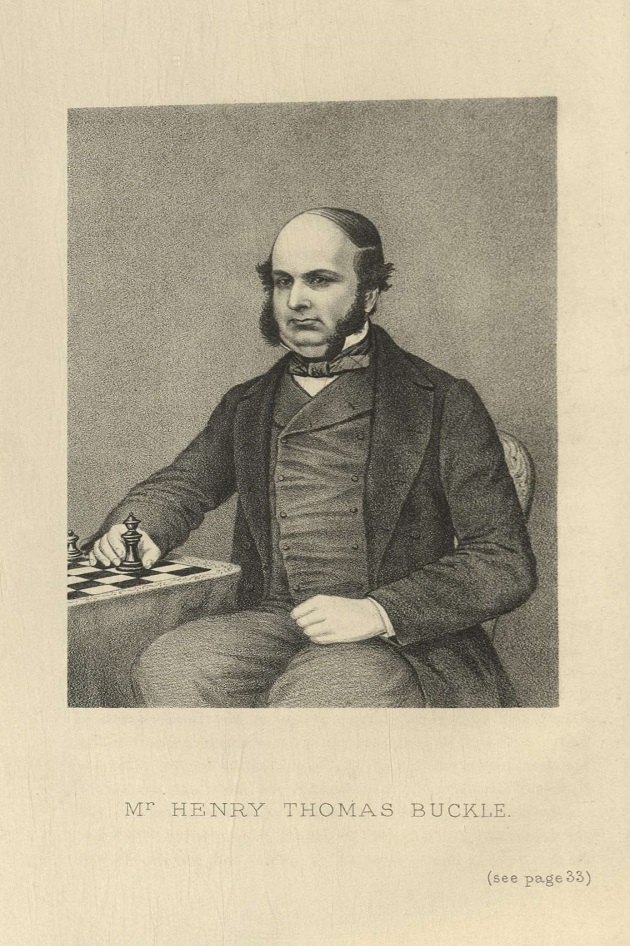
10449. Kestler v Pesch
The conclusion of Kestler v Pesch, Traben-Trarbach, 1956 has been widely published, but is the full game available?
From page 153 of How To Get More Out Of Chess by F. Reinfeld (New York, 1957):
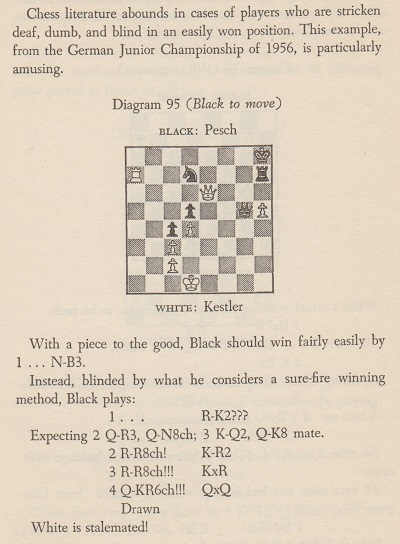
10450. The Bxf7+/...Bb4+ theme (C.N.s 10444 & 10447)
Paul Dorion (Montreal, Canada) points out that Larsen v Teschner, Wageningen, 1957 was discussed on pages 166-167 of How to Open a Chess Game (New York, 1974), in Larsen’s chapter ‘A Personal Approach to the Openings’. His note after 12...Ke6 on page 166:
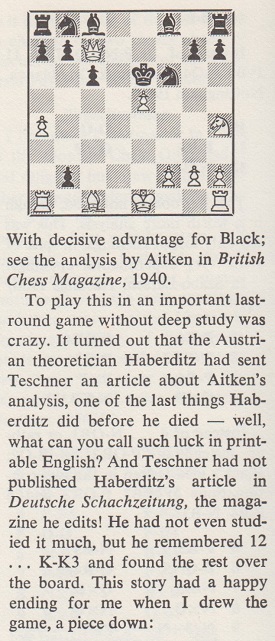
Below is the article by J.M. Aitken referred to by Larsen, from page 148 of the May 1940 BCM:
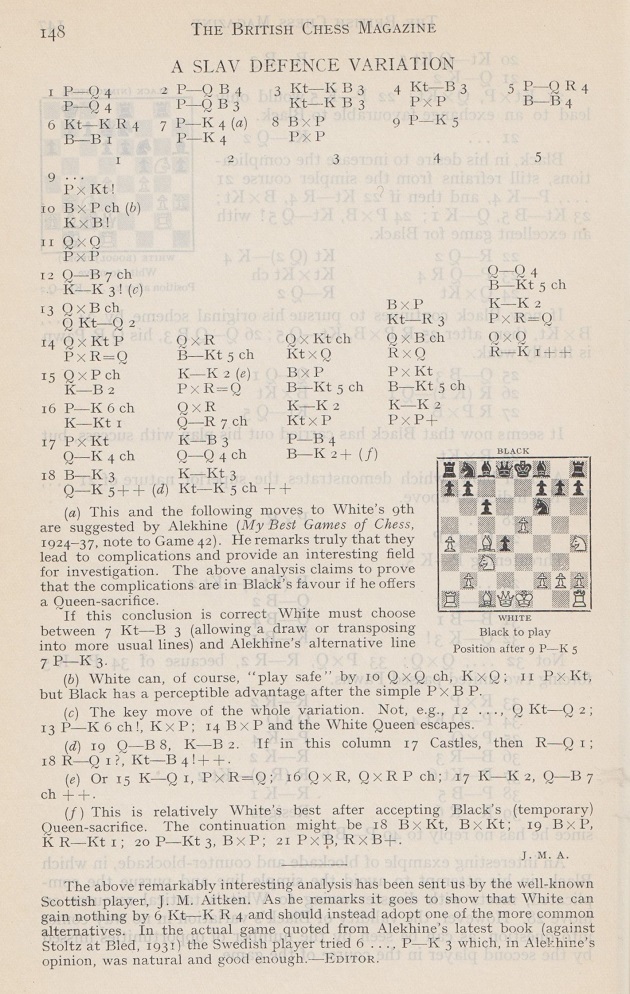
10451. Spassky v Fischer, Reykjavik, 1972
In C.N. 8135 (see Spassky v Fischer, Reykjavik, 1972) Lubomir Kavalek (Reston, VA, USA) wrote:
‘I took over the second’s duties during the adjournment of the 13th game after Fischer sent Lombardy away. I was analysing with Fischer alone until the end of the match. We also spent time walking together, swimming and bowling. To my knowledge, there were only three other people (Bill Lombardy, Fred Cramer and Brad Darrach) who had daily contact with Fischer away from the playing hall.’
Aðalsteinn Thorarensen (Reykjavik) asks why Sæmundur Pálsson was not also mentioned, and we have put the question to Lubomir Kavalek. His reply:
‘I was more concerned about the chess experts around Bobby Fischer, and I did not think of Sæmi Pálsson. He was more visible after the match. I did not see him driving with us to the US Army base in Keflavík, or during our midnight swims and walks, and he was not in Fischer’s room during our analysis. Nor was he in Fischer’s villa during our interview after the match, although this does not mean that he was not around. I did notice the Life photographer Harry Benson, who showed up regularly while he was on the island.’
10452. Stoltz v Capablanca
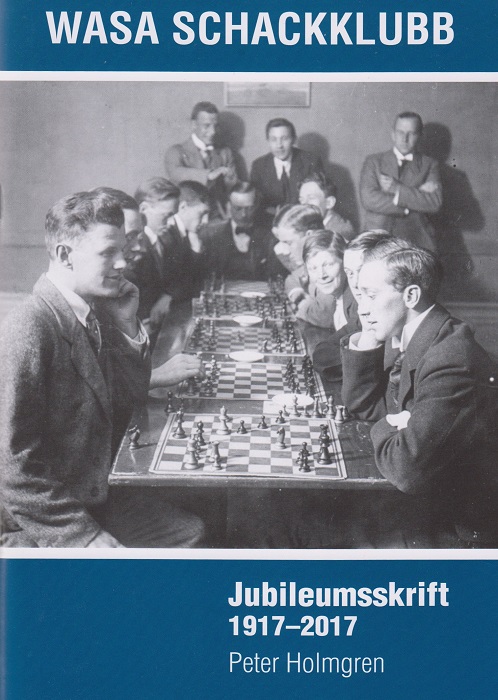
Page 9 of Wasa Schackklubb by Peter Holmgren (Tallinn, 2017) has a photograph of Stoltz in play against Capablanca, and we are grateful to Mr Holmgren for permission to show it here:
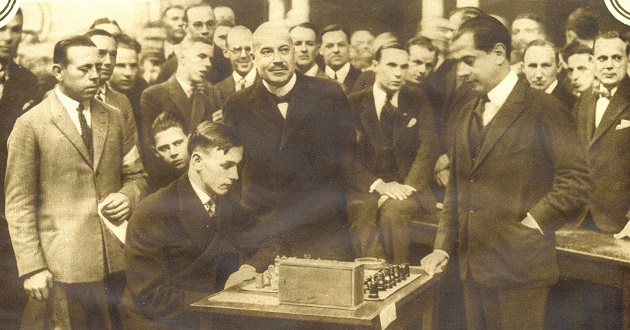
The occasion was a seven-board simultaneous display with clocks in Stockholm on 4 November 1928. Page 244 of our book on Capablanca gave information about the event, as well as his loss to Stoltz (taken from page 16 of Stockholms-Tidningen, 5 November 1928). The game was also published on pages 16-17 of the December 1928 issue of Tidskrift för Schack.
10453. Jottings about Coles on Nimzowitsch
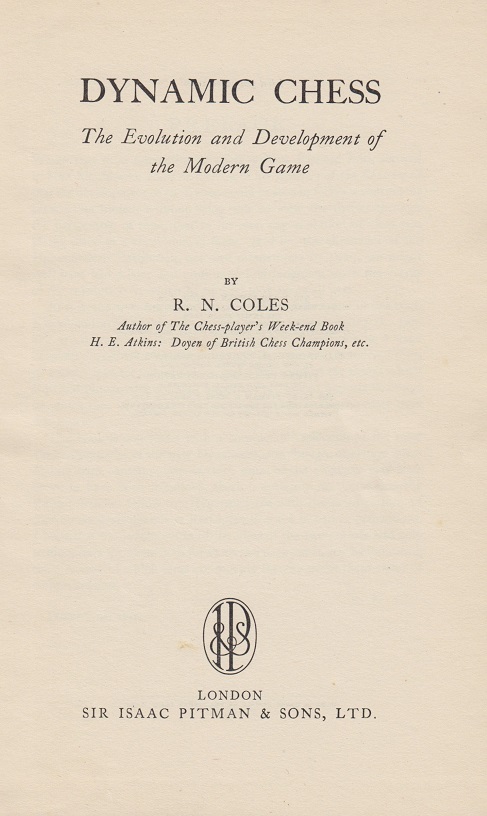
The sections on Nimzowitsch in R.N. Coles’ highly-regarded book Dynamic Chess (London, 1956) may be read in conjunction with two articles contributed by Coles to Chess Review that year: ‘New Light on Nimzovich’ (April, pages 108-109) and ‘The Negative Dynamism of Nimzovich’ (November, page 334).
The former article began:
‘That strange genius, Aron Nimzovich, was a chessmaster of many parts, but in no way was his genius more strikingly illustrated than in his ability to convince the world that Aron Nimzovich was a genius and a true original.
Closer examination reveals that Nimzovich’s claims cannot always be substantiated, as for example in his claim to be the discoverer of the theory of over-protection. “That strategically important points”, he writes in his Chess Praxis, “should be over-protected is a principle discovered by the author.” My answer to that is, “Nonsense!”’
Coles subsequently wrote:
‘... all that Nimzovich really did was to invent the phrase, “over-protection”, and for so doing he won all the credit (plus a good deal of adverse criticism) for the idea of over-protection.
In point of fact, he was merely filching an idea from Steinitz, dressing it up as his own and presenting it as part of MY System.’
Coles then gave Steinitz v Weiss, Vienna, 1882, with notes from Dynamic Chess, to demonstrate that Steinitz ‘knew all about over-protection nearly half a century before Nimzovich launched it on the world as his own’.
He concluded:
‘I am not denying Nimzovich his great ability as a player, nor that he was an original thinker, but merely pricking that bubble of bluff which he also handled like a master of another kind ...
I hope that Dynamic Chess will prove illuminating, not merely as putting a few of the Hypermodern ideas in their proper context but also as a review of the Dynamic style of which Nimzovich was genuinely one of the founders, though in some respects to a lesser extent than he himself would have had us believe.’
An editorial footnote quoted a letter from Coles:
‘The article [above] is more polemical than the book [is] on the same subject, since I did not feel that the book was the place to start up hares (or red herrings) of this nature. ... I feel that, if Nimzovich is to be debunked in some small degree, an article rather than a general treatise is the place for it.’ (Ellipses and additions in square brackets are as in the original.)
Concerning over-protection (Überdeckung), we seek early sightings of the term. From page 159 of the September 1901 Wiener Schachzeitung:

The problem was on page 161:
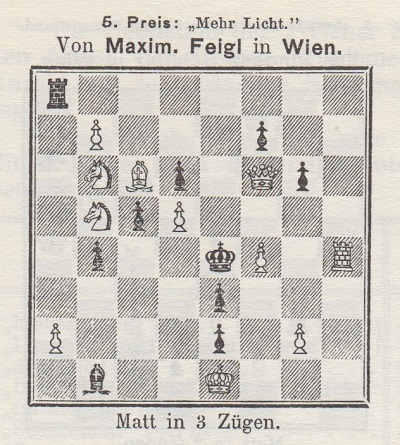
The composition had also been published on page 139 of the July 1901 Wiener Schachzeitung. The solution was on page 22 of the January 1902 issue.
Below is Wolfgang Heidenfeld’s entry on over-protection on page 230 of The Encyclopedia of Chess by Harry Golombek (London, 1977):
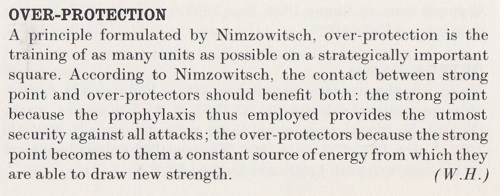
We add without comment what Nathan Divinsky gave on page 154 of The Batsford Chess Encyclopedia (London, 1990):
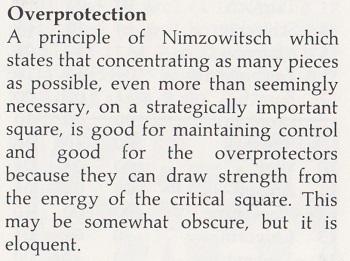
A third-person summary of the above-mentioned Steinitz v Weiss game was published by Steinitz in his Field column of 3 June 1882:
‘Steinitz treated the French defence, adopted by Weiss, in the same fashion as against Fleissig, viz with the new move 2 P to K5, to which Weiss replied 2...P to QB4. Steinitz then proceeded with P to KB4 and the K fianchetto. He carefully abstained from all attempts at exchanging his QP against the QBP, but kept the QP at Q3. He, however, exchanged immediately, in passing, his KP for the adverse QP as soon as the latter advanced, and he thus obtained the open K file, which, according to his idea, should be the main object of the attack. White had a good game throughout; and, after having well secured the Q side, he opened an attack on the K side, which forced the gain of a P and brought the adverse K into serious trouble. Steinitz wound up with an interesting sacrifice of the exchange, which forced a mate after four hours’ play.’
The second Chess Review article by R.N. Coles in 1956 (November issue, page 334), ‘The Negative Dynamism of Nimzovich’, stated:
‘Nimzovich, instead of seeking at all costs to increase the dynamic potentialities of his own position, played instead to reduce at all costs the dynamic potentialities of his opponent’s position.’
After a discussion of certain openings favoured by Nimzowitsch, there came this key section:
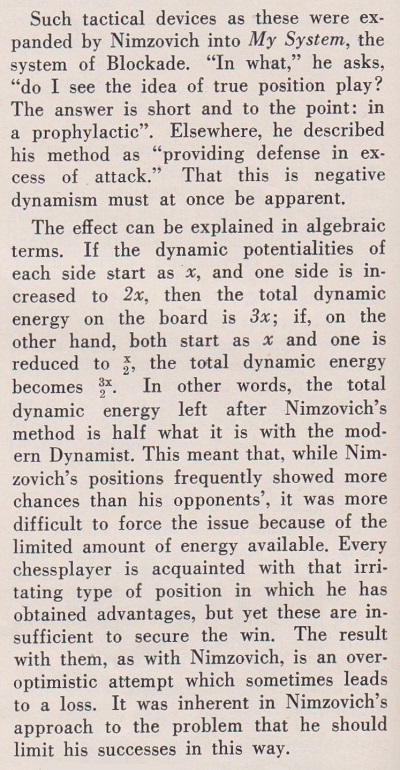
Under the title ‘The Evolution of Chess Method’ R.N. Coles also discussed Dynamic Chess, although not Nimzowitsch, on page 317 of CHESS, 8 September 1956, following a book review on page 246 of the 26 May issue and a letter from a reader, J. Taylor, on page 278 of CHESS, 7 July.
10454. Complete
From page 108 of Chess Review, April 1956:
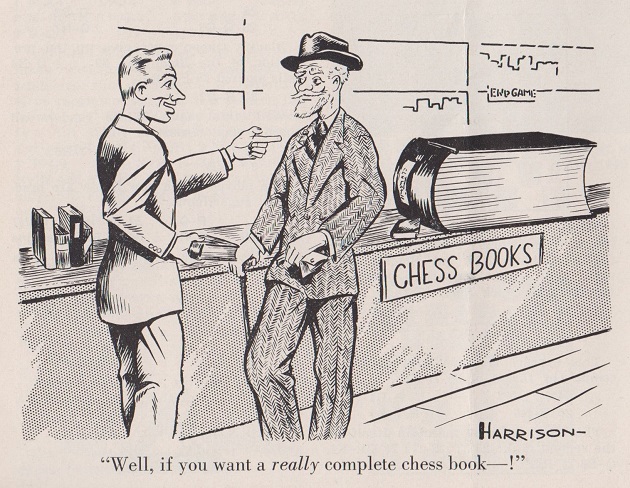
10455. R.N. Coles (C.N. 10453)
Some games played by the chess historian and theoretician R.N. Coles (1907-82):
Richard Nevil Coles – M. Benger
Surrey Championship, 1936
Ruy López
1 e4 e5 2 Nf3 Nc6 3 Bb5 a6 4 Ba4 d6 5 Bxc6+ bxc6 6 d4 f6 7 Be3 g6 8 Qd2 Bg7 9 h3 Ne7 10 Nc3 Be6 11 dxe5 fxe5 12 Ng5 Bg8 13 O-O d5 14 Bc5 d4 15 Ne2 Nc8
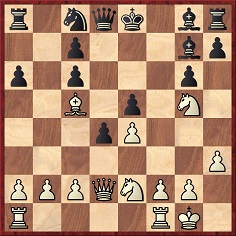
16 f4 Bh6 17 fxe5 Bc4 18 h4 Bxg5 19 hxg5 Bxe2 20 Qxe2 Qxg5 21 Rad1 Qe3+ 22 Qxe3 dxe3 23 Bxe3 Nb6 24 Bxb6 cxb6 25 Rd6 Rf8 26 Rff6 Rxf6 27 exf6 Rc8 28 e5 Kf7 29 Rd7+ Ke6 30 Re7+ Kf5 31 g4+ Kg5 32 f7 Rf8 33 e6 Kf6 34 Re8 Kg7 35 g5 Resigns.
Source: BCM, February 1942, page 42. ‘Another peace-time game of a reader sent by White.’
Gilbert V. Butler – Richard Nevil Coles
Battersea v Kingston match (date?)
Alekhine’s Defence
1 e4 Nf6 2 Nc3 d5 3 exd5 Nxd5 4 d4 Nxc3 5 bxc3 g6 6 Bd3 Bg7 7 Ne2 O-O 8 O-O c5 9 Be3 Bg4 10 f3 cxd4 11 cxd4 Be6 12 Rb1 Nc6 13 Rxb7 Nxd4 14 Be4 Nxe2+ 15 Qxe2 Bxa2
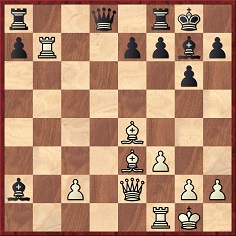
16 Rd1 Bc4 17 Qe1 Bc3 18 Rxd8 Bxe1 19 Rxa8 Rxa8 20 Rb1 Resigns.
Source: BCM, January 1943, page 12. This game was in the obituary of G.V. Butler.
G.H. Barrett – Richard Nevil Coles
Correspondence game, 1945
English Opening
1 c4 e5 2 Nc3 Nf6 3 Nf3 Nc6 4 d4 exd4 5 Nxd4 Bb4 6 Bg5 h6 7 Bh4 g5 8 Bg3 d6 9 e3 Qe7 10 Nxc6 bxc6 11 Qb3 Bxc3+ 12 Qxc3 Bf5 13 c5 Kd7 14 cxd6 cxd6 15 Rc1 Rhc8 16 Ba6 Rc7 17 O-O Ne4 18 Qa5 Bg6 19 Rfd1 f6 20 Rc4 Nxg3 21 hxg3 Rb8
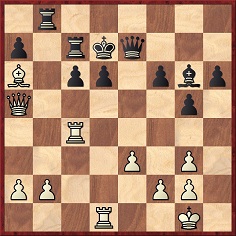
22 Rxd6+ Qxd6 23 Rd4 Qxd4 24 exd4 Rxb2 25 Qa3 Rb1+ 26 Kh2 Rb8 27 Qc5 Be4 28 Bc4 Rcb7 29 f3
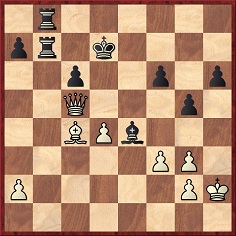
29...Bd5 30 Bxd5 cxd5 31 Qxd5+ Ke7 32 Qe4+ Kf7 33 Qh7+ Ke6 34 Qxh6 Rd7 35 Qh3+ Ke7 36 Qf5 Rbd8 37 g4 Rxd4 38 Qc5+ Kf7 39 Qxa7+ R4d7 40 Qb6 Ra8 41 f4 gxf4 42 Qb4 Rda7 43 Qxf4 Kg7 44 g5 fxg5 45 Qxg5+ Kh8 Drawn.
Source: BCM, September 1945, pages 222-223. The game, between ‘P/O. G.H. Barrett’ and ‘Lt R.N. Coles’, had the latter’s notes. It was ‘played in a BCCA Forces tourney, January to June 1945’.
Richard Nevil Coles – E.W. Driver
Correspondence game
Giuoco Piano (Møller Attack)
1 e4 e5 2 Nf3 Nc6 3 Bc4 Bc5 4 c3 Nf6 5 d4 exd4 6 cxd4 Bb4+ 7 Nc3 Nxe4 8 O-O Bxc3 9 d5 Bf6 10 Re1 Ne7 11 Rxe4 d6 12 Bg5 Bxg5 13 Nxg5 O-O 14 Nxh7 Kxh7 15 Qh5+ Kg8 16 Rh4 f5 17 Re1 Ng6 18 Rh3 Rf6 19 Rg3 Kf7 20 Bb5 Bd7 21 Bxd7 Qxd7
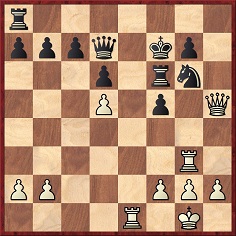
22 Rxg6 Rxg6 23 Re6 Qxe6 24 dxe6+ Kf6 25 Qf3 Rd8 26 Qxb7 Kxe6 27 Qxc7 Rd7 28 Qc4+ d5 29 Qc6+ Rd6 30 Qe8+ Kf6 31 f4 d4 32 Kf2 d3
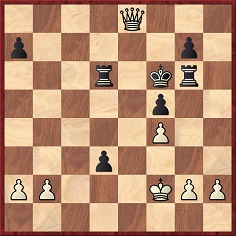
33 g4 fxg4 34 Qf8+ Ke6 35 f5+ Kd7 36 fxg6 d2 37 Qxd6+ Kxd6 38 Ke2 Kd5 39 Kxd2 Kd4 40 Ke2 Ke4 41 Kf2 Kf4 42 b4 g3+ 43 hxg3+ Ke4 44 b5 Resigns.
Source: BCM, June 1947, page 193. The game was from ‘last season’s Major Tournament’.
Richard Nevil Coles – Vernon Dilworth
Correspondence game, 1947
Giuoco Piano
1 e4 e5 2 Nf3 Nc6 3 Bc4 Bc5 4 c3 Qe7 5 O-O Nf6 6 b4 Bb6 7 a4 a6 8 d4 d6 9 a5 Ba7 10 b5 axb5 11 Bxb5 O-O 12 Bxc6 bxc6 13 Ba3 Nd7 14 Nbd2 Ba6 15 Re1 Qf6 16 Nf1 Rfe8 17 Ng3 Rab8 18 Bc1 h6 19 Be3 exd4 20 Bxd4 Bxd4 21 cxd4 d5 22 exd5 Rxe1+ 23 Qxe1 cxd5 24 Qc1 c6 25 h3 Rb5 26 Qe3 Nc5 27 Qe8+ Kh7 28 Ne5 Nb3 29 Nh5 Qg5
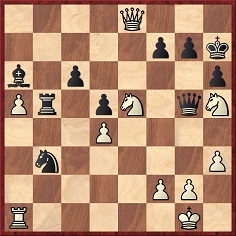
30 Nxf7 Qxh5 31 Qh8+ Kg6 32 Ne5+ Kf6 33 g4 Rb7 34 Qd8+ Ke6 35 Qc8+ Ke7 36 Re1 Resigns.
Source: BCM, March 1948, page 83. The game was in the column of the British Correspondence Chess Association with the heading ‘played in the Premier Tournament, 1947’.
R.N. Coles sent us the following autobiographical note in a letter dated 4 April 1979:
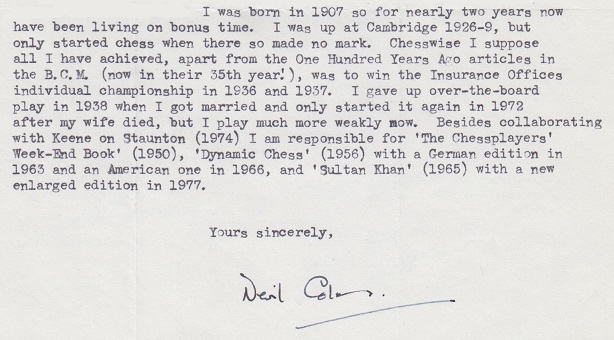
10456. A photograph
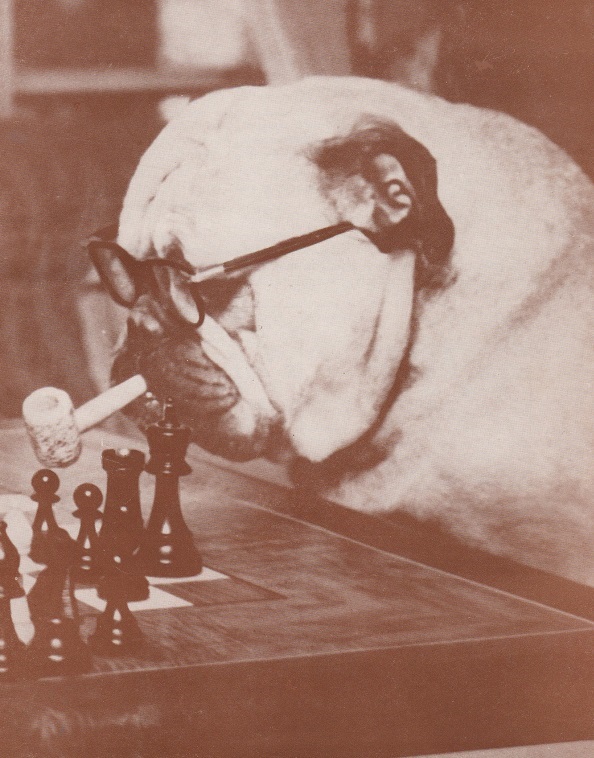
Chess Review, January 1955, front cover
This is the kind of photograph that writers and editors seem incapable of reproducing without a trite pun.
10457. ‘A remarkable position’
From page 113 of the May 1901 American Chess World:
J.W. Cowles – E.P. Updegraff
Correspondence game (‘Twentieth Century
Tournament’)
Giuoco Piano
1 e4 e5 2 Nf3 Nc6 3 Bc4 Bc5 4 c3 Nf6 5 O-O d6 6 d4 exd4 7 cxd4 Bb6 8 e5 dxe5 9 dxe5 Ng4 10 Qe2 O-O 11 h3 Nh6 12 Bxh6 gxh6 13 e6 fxe6 14 Bxe6+ Bxe6 15 Qxe6+ Kg7 16 Nc3 Rf6 17 Qe4 Qg8 18 Rad1 Raf8 19 Nd5 Re6 20 Qd3 Ba5 21 b4 Bb6 22 Nxb6 cxb6 23 a3 Ref6 24 b5 Nb8 25 Qc3 Kh8 26 Ne5 h5 27 Rd3 Qg5 28 Rfd1 Qf5 29 Rf3 Qg5
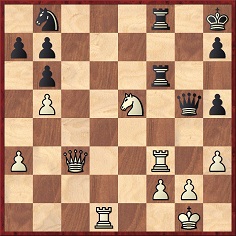
30 Rd8 Qg7 31 Nf7+ (‘A remarkable position, in which Bucephalus does the trick.’) 31...Kg8 32 Rxf8+ Resigns.
The ‘Twentieth Century Tournament’ was described on page 11 of the Brooklyn Daily Eagle, 20 January 1901. Organized by the Pillsbury National Correspondence Chess Association, it brought together 175 players in 25 sections. J.W. Cowles and E.P. Updegraaf were named as participants in Section 2 of the Midland Division.
10458. Staunton
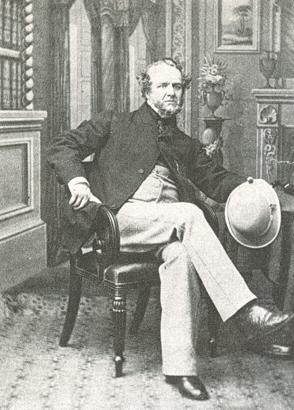
This image was discussed in C.N.s 5942 and 5988 (see too Pictures of Howard Staunton).
Below is an extract from a letter to us from David Lawson dated 15 May 1979:
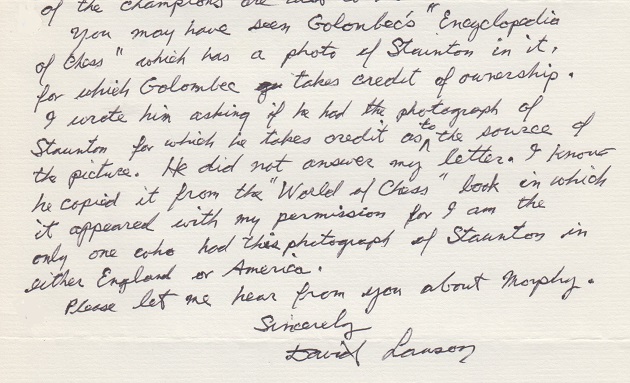
10459. W.H.K. Pollock (1859-96)
Just received: W.H.K. Pollock. A Chess Biography with 523 Games by Olimpiu G. Urcan and John S. Hilbert (Jefferson, 2017).
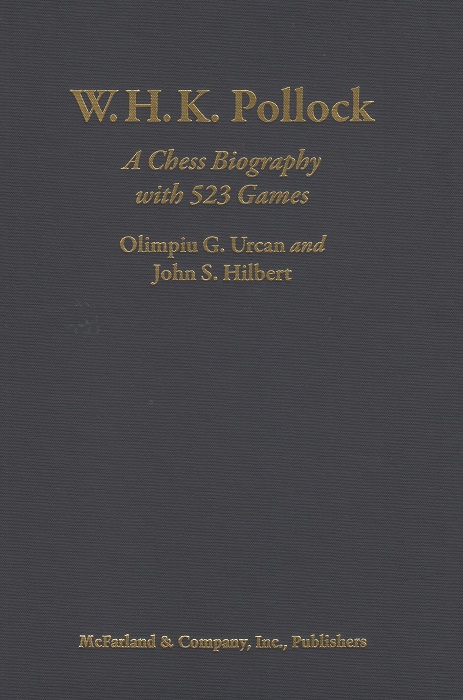
For now, we merely show an extract from page 2 of the Morning Post, 14 May 1900:
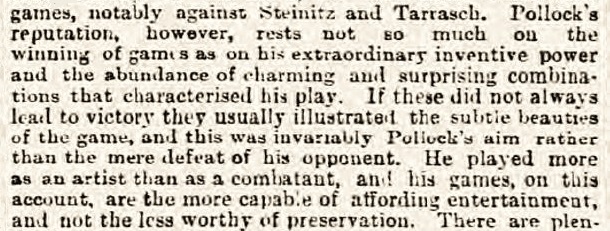
On page 466 the co-authors quote this passage, praising it as ‘perhaps best summing up Pollock’s finest traits as a chess player’.
A portrait of Pollock from opposite page 46 of the Hastings, 1895 tournament book:
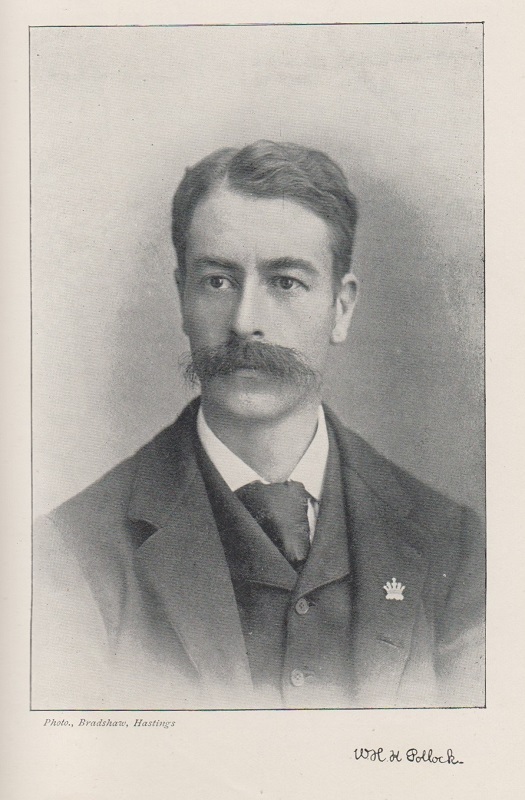
10460. The Bxf7+/...Bb4+ theme (C.N.s 10444, 10447 & 10450)
Luc Winants adds Zlotnik v Mikliaev, USSR, 1968 (included in Chess Informant, volume six), which began:
1 e4 e5 2 Nf3 Nc6 3 Bb5 a6 4 Ba4 d6 5 d4 b5 6 Bb3 Nxd4 7 Nxd4 exd4 8 c3 dxc3 9 Nxc3 Nf6 10 e5 dxe5
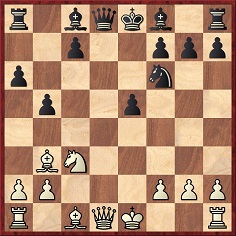
11 Bxf7+ Ke7 12 Bd5 Nxd5 13 Nxd5+ Ke6 14 Qg4+ Kxd5 15 Qd1+ Ke6 16 Qxd8 Bb4+ 17 Qd2 Bxd2+ 18 Bxd2. The game was drawn at move 41.
Our correspondent notes that the first ten moves were seen in Fontein v Loman (C.N. 9675), and that a similar version of the 1968 game occurred in Sanal v Adhiban, World Rapid Championship, Doha, 2016.
Another noteworthy game is Bilek v Schüssler, Helsinki, 1978:
1 c4 b6 2 d4 e6 3 Nf3 Bb7 4 g3 Bxf3 5 exf3 d5 6 Nc3 dxc4 7 Bxc4 c6 8 d5 exd5 9 Nxd5 Ne7 10 Nf6+ gxf6
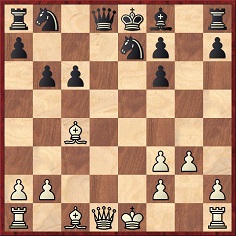
11 Bxf7+ Kxf7 12 Qxd8 Nd5 Drawn.
The score is in volume 26 of Chess Informant, and databases have a number of similar later games. Acknowledgement: Thomas Binder (Berlin) and Joose Norri (Helsinki).
Finally, Frits Fritschy (Leiden, the Netherlands) writes:
‘Some opening analysis of mine: 1 d4 d5 2 c4 dxc4 3 e4 e5 4 Nf3 exd4 5 Bc4 Bb4+ 6 Nc3 dxc3
7 Bxf7+ Kxf7 8 Qxd8 cxb2+ 9 Ke2 bxa1(Q) 10 Ng5+, and White wins. I first played the line in a Dutch team competition in 2000 against Michael Aagard, who refused the offer.’
10461. Howard Staunton and acting
In C.N. 4776 a correspondent wrote:
‘The obituary in The Times, 30 June 1874, page 8, quoted a press release from the Athenaeum which appears to be the source for several of the “facts” about his life, e.g. that he attended Oxford without taking a degree and that he once played Lorenzo to Kean’s Shylock.’
Sean Robinson (Tacoma, WA, USA) asks whether detailed research has been undertaken into claims that Staunton was an actor.
We believe that the best treatment of the subject, though still inconclusive, is by John Townsend on pages 25-30 of Notes on the life of Howard Staunton (Wokingham, 2011).
10462. Punctured vanity
Capablanca features extensively in Chess and Sleep, but there is another yarn to be added. From page 3 of the Linlithgowshire Gazette, 6 September 1912:
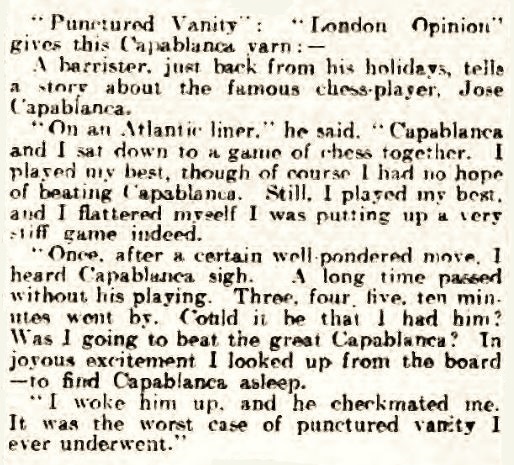
The item also appeared the same day on page 8 of the Western Daily Mercury. Can its publication in the London Opinion be traced?
Another sighting, from page 6 of the 17 October 1912 issue of the Eagle:
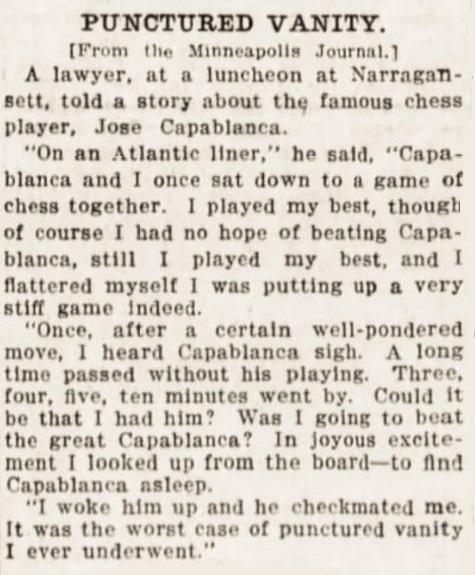
10463. ‘The father of hypermodern chess’
C.N.s 2323, 4773 and 8687 discussed the nickname ‘The father of modern chess’. Concerning ‘The father of hypermodern chess’, citations for Nimzowitsch (and, even, Tartakower) are easily found, but there is also an article about Louis Paulsen by Imre König on pages 234-236 of CHESS, 19 February 1955:
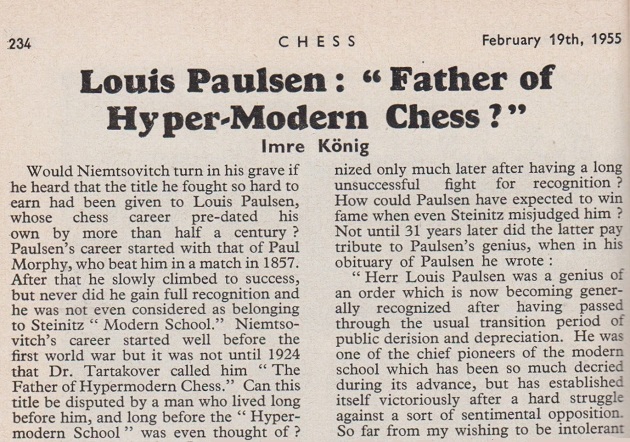
10464. Morphy and Steinitz
From a column by Fred Reinfeld (Chess Review, March 1952, page 77):
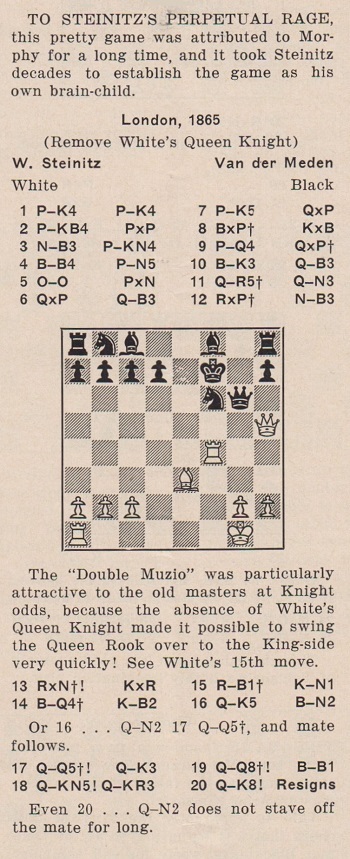
Reinfeld appeared unaware that, less than a decade earlier, a very similar game had been played by Morphy. Nothing has been found to justify the assertion that Steinitz was in a ‘perpetual rage’ with regard to his Muzio Gambit game.
Establishing the basic facts about either game is not easy. For example, the name of Steinitz’s opponent appears inconsistently in chess literature. Reinfeld also named him as ‘van der Meden’ on pages 40-42 of Great Moments in Chess (New York, 1963), which had this introduction: ‘Games like the following one show how Steinitz acquired the nickname of “the Austrian Morphy”.’ Chernev’s 1000 Best Short Games of Chess (pages 341-342) called him ‘Meden’. Pages 97-98 of the first volume of Bachmann’s monograph on Steinitz had ‘Van der Meelen’ and offered an occasion: the London Club, 10 December 1865. However, that is the exact date when the game was published, with Black unidentified, in the Era (page 4):
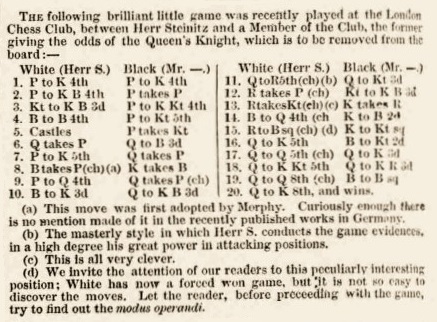
The similar game by Morphy referred to above was on page 206 of the July 1858 Chess Monthly:
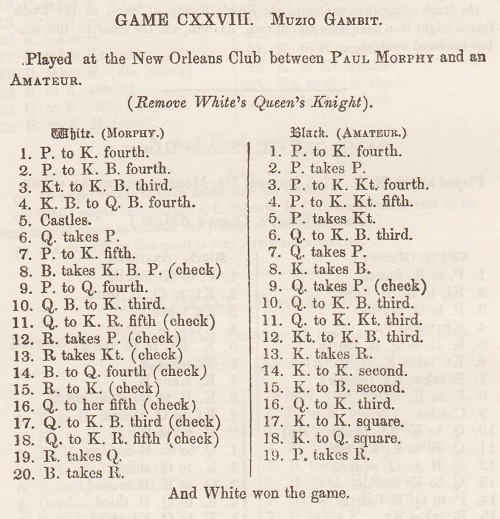
The venue specified above is the New Orleans Chess Club, but a number of Morphy anthologies place the game in New York (with the date 1857).
Both games were discussed by Steinitz in a series of ‘Personal and General’ articles in the International Chess Magazine, May, June, July and August 1885. On pages 210-211 of the July 1885 issue, Steinitz stressed his familiarity with the Morphy game, noting its publication in the Chess Monthly. See too pages 71-80 of The Steinitz Papers by Kurt Landsberger (Jefferson, 2002).
Writing before clarification of the exact year of his game had been provided, Steinitz stated on page 143 of the May 1885 International Chess Magazine:
‘I played the game, a Muzio Gambit at the odds of a Kt, at the old London Chess Club, against Herr van der Meden, then Belgian Consul in London, in the year 1866 at the very latest.’
On page 14 of The Transactions of the British Chess Association for the Years 1866 and 1867 by J. Löwenthal and G.W. Medley (London, 1868) a list of subscribers included ‘Von der Meden, O.’.
10465. 1895 photographs
Olimpiu G. Urcan (Singapore) writes:
‘On the topic of similar photographs (C.N.s 5372, 5405, 6709, 7429 and 7724), page 193 of the recent Pollock biography reproduces a picture of him from page 138 of Sportfolio: Portraits and Biographies of Heroes and Heroines of Sport and Pastime (London, 1896). Our caption states that the photograph, by George Bradshaw, is also featured in the Hastings, 1895 tournament book edited by Horace F. Cheshire. In fact, the Pollock portrait given opposite page 46 of the latter work (shown in C.N. 10457) is slightly, almost imperceptibly, different, although undoubtedly taken on the same occasion:
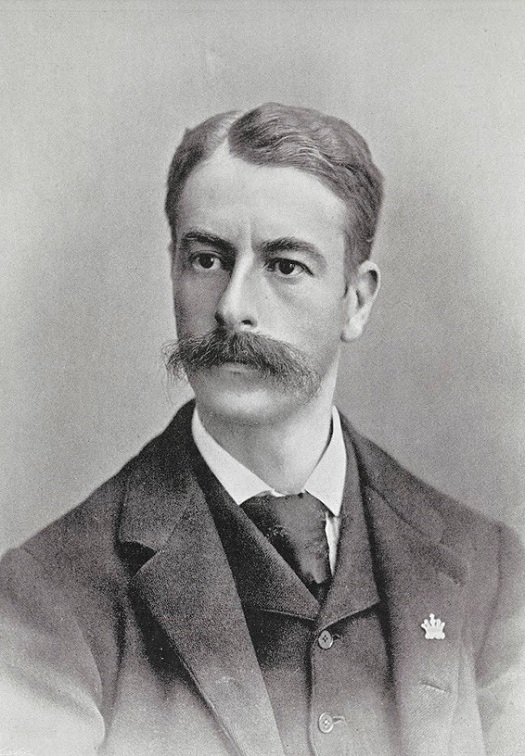
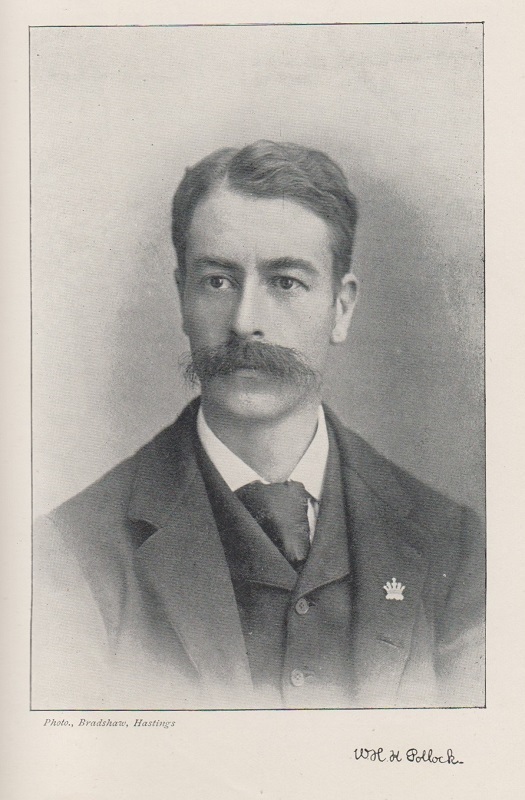
Our book also has photographs of Chigorin (page 58) and Tarrasch (page 185) taken during the Hastings, 1895 tournament by William James Donald. They are different from the Bradshaw photographs opposite pages 121 and 60 respectively of Cheshire’s book.
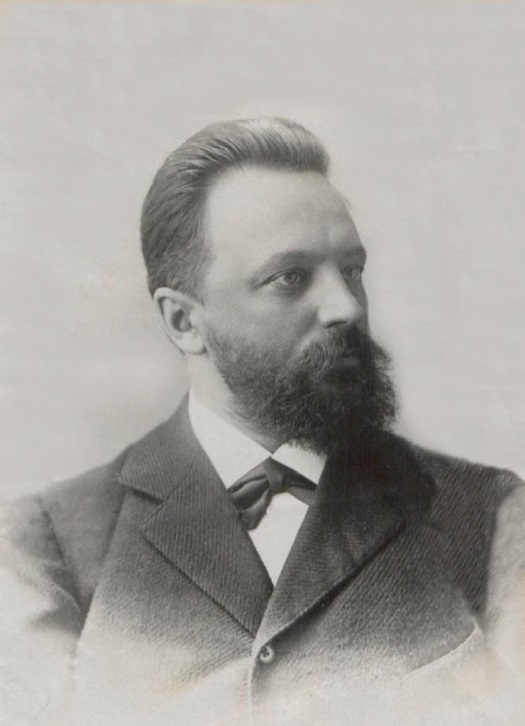
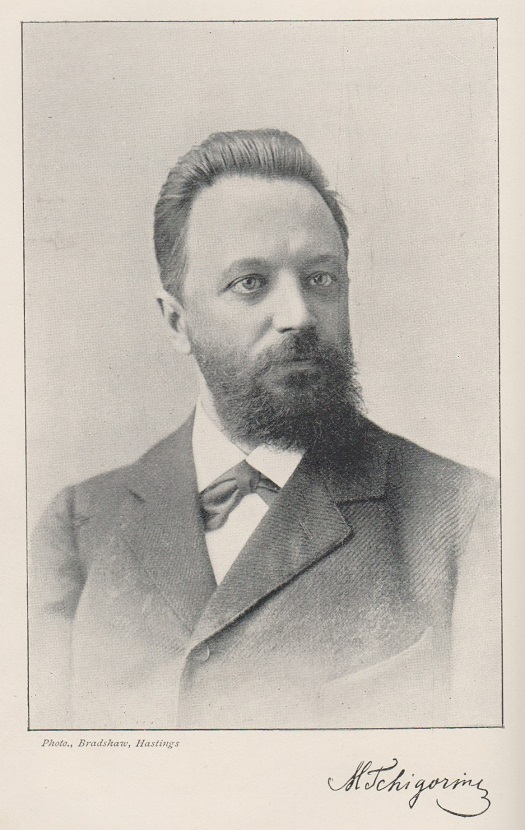
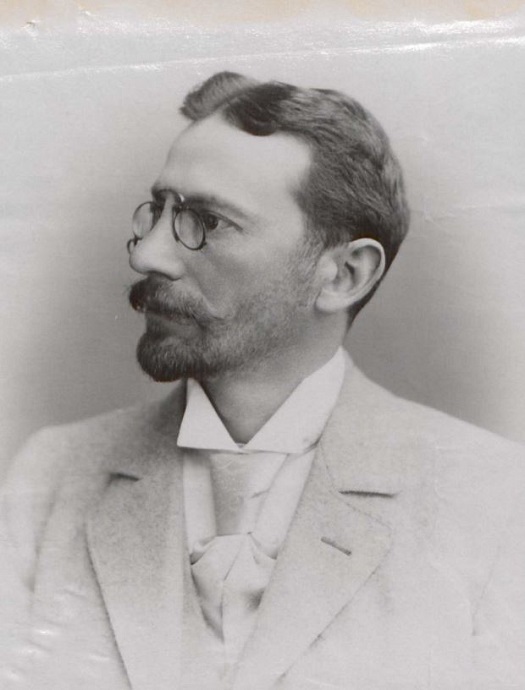
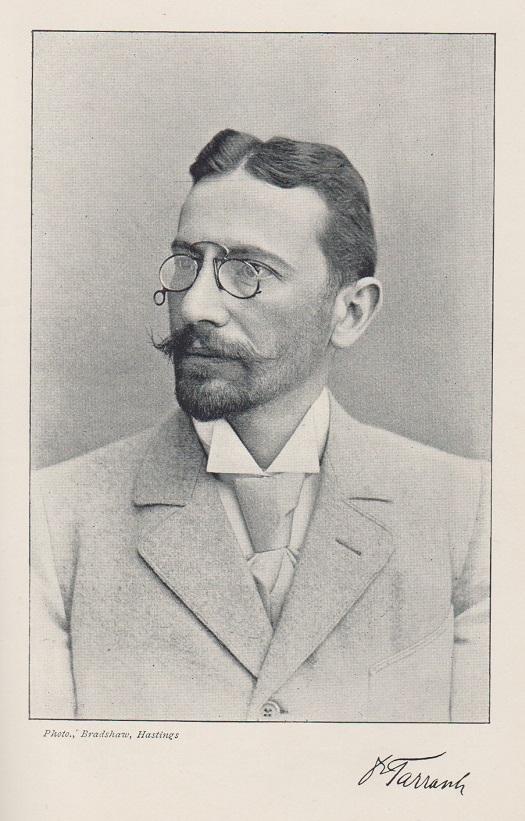
On the other hand, Donald’s photographs of Steinitz and Pillsbury in the Pollock volume (pages 181 and 189) are identical to the Bradshaw photographs in the tournament book. Can further versions of such 1895 photographs involving the Hastings participants be found?’
10466. Staunton and acting (C.N. 10461)
From John Townsend (Wokingham, England):
‘If the story is true that Howard Staunton played Lorenzo to Edmund Kean’s Shylock, a likely venue is the small theatre at Deptford, for the reasons given on page 26 of my 2011 book Notes on the life of Howard Staunton.
One small development since 2011 has been identification of a performance in which Kean played Shylock at Deptford. Page 3 of the Morning Post of 14 March 1831 reported that Kean had played that role in The Merchant of Venice at the Deptford Theatre the previous Saturday, 12 March, for the benefit of a Mr Ormond, to a full house.
I have not discovered who took the part of Lorenzo. If a playbill for the performance has survived, it should contain the name of the actor, but none has been located so far.’
| First column | << previous | Archives [154] | next >> | Current column |
Copyright: Edward Winter. All rights reserved.
